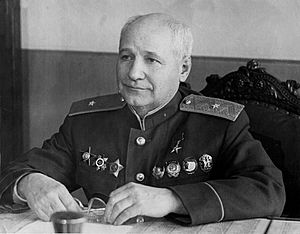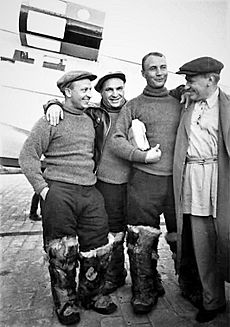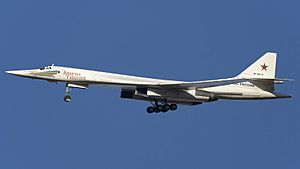Andrei Tupolev facts for kids
Quick facts for kids
Andrei Tupolev
|
|
|---|---|
| Андрей Туполев | |

Tupolev in his office in 1944
|
|
| Born |
Andrei Nikolayevich Tupolev
10 November [O.S. 29 October] 1888 Pustomazovo, Tver Governorate, Russian Empire
|
| Died | 23 December 1972 (aged 84) |
| Resting place | Novodevichy Cemetery, Moscow |
| Nationality | Russian, Soviet |
| Occupation | Engineer |
| Engineering career | |
| Discipline | Aeronautical Engineering |
| Employer(s) | Tupolev Design Bureau |
| Significant design | Tu-95, Tu-104 |
| Awards | Hero of Socialist Labor Order of Lenin Order of the Red Banner of Labour |
| Signature | |
 |
|
Andrei Nikolayevich Tupolev (Russian: Андрей Николаевич Туполев; 10 November 1888 – 23 December 1972) was a famous Russian and later Soviet engineer. He was a pioneer in designing aircraft. He led the Tupolev Design Bureau and created many important planes.
Tupolev was one of the first people to study aeronautics (the science of flight) in Russia. He was a student of Nikolay Zhukovsky, a well-known aviation expert. Over 50 years, Tupolev designed or helped design more than 100 types of planes. These included both planes for everyday use and military aircraft. Some of his designs even set 78 world records!
Some of his most famous planes include the Tu-2, Tu-16, Tu-95, and Tu-104. He also helped create the Tu-4 by studying an American bomber. Tupolev received many awards and honors in the Soviet Union for his amazing work. He was also recognized by aviation groups in Britain and America. In 2018, Vnukovo International Airport in Moscow was renamed in his honor.
Contents
Early Life and Education

Andrei Nikolayevich Tupolev was born on 10 November 1888. He grew up in a small village called Pustomazovo, near the city of Kimry in the Russian Empire. He was the sixth of seven children. His father, Nikolai Ivanovich Tupolev, was a notary. His mother, Anna Vasilievna, came from a family of legal investigators.
Andrei first learned at home. Later, he went to a school called a Gymnasium in Tver. He finished school in 1908. He then chose to study at the Imperial Moscow Technical School (IMTU).
In 1909, Tupolev began studying aerodynamics with Nikolay Zhukovsky. Zhukovsky was a pioneer in Russian aviation. Tupolev joined Zhukovsky's Aeronautical workshop. In 1910, Tupolev and his friends built and tested their first glider. He also built a wind tunnel at IMTU. This led to the creation of an aerodynamic laboratory there.
In 1911, Tupolev faced some trouble and was arrested. He was accused of being involved in revolutionary activities. He was later released but had to go back to his family home. He could only return to IMTU in 1914. He continued his studies during World War I and the Russian Revolution. In 1918, he finished his studies. He earned a degree in Engineer-Mechanics after presenting his ideas on seaplanes. By 1920, Tupolev was teaching about aerodynamic calculations at the school.
Designing Aircraft
Leading the Central Aerohydrodynamic Institute
Tupolev became a very important person at the Central Aerohydrodynamic Institute (TsAGI) in Moscow. He worked there from 1929 until he passed away in 1972. This institute designed bombers for the Soviet Air Force and also airliners. Before World War II, many of his designs used ideas from Hugo Junkers about all-metal aircraft.
In 1925, Tupolev designed the TB-1, a bomber with two engines. It was considered a very advanced design for its time. By 1934, Tupolev led the team that designed the largest aircraft in the world then. It was called the Maksim Gorki. This plane had a wingspan of 63 meters and eight engines. It also used the metal structure ideas from Junkers. In 1937, an improved version of the TB-1, the four-engined TB-3, even landed at the North Pole. As more aircraft designers became skilled, Tupolev started his own design office. His designs were given the prefix ANT, which came from his initials.
Working in Difficult Times
On 21 October 1937, Tupolev was arrested during a difficult period in the Soviet Union. Many of his colleagues were also arrested. He was accused of various crimes, but these charges were not true. Many of his friends were executed, but Tupolev was put in prison.
In 1939, Tupolev was moved to a special prison for engineers. This place was called a sharashka. Many other aircraft designers who had been arrested were sent there to work. This sharashka later moved to Moscow and was nicknamed "Tupolevka" because Tupolev was its most famous prisoner. In 1940, he was sentenced to ten years in prison. During this time, he designed the Tupolev Tu-2. This plane became one of the most important aircraft of World War II. Tupolev was released in July 1941, around the time Germany invaded the Soviet Union. He was released to work on important defense projects. However, he was not fully cleared by the Soviet government until 1955.
After the War
After the war, Tupolev led a project to study and rebuild the American Boeing B-29 Superfortress bomber. This was the first plane to drop a nuclear weapon. The Soviet Union wanted B-29s during World War II, but the US did not give them any. Tupolev successfully redesigned the B-29 using Russian engines, weapons, and equipment. He had to change almost everything because the original plane was built using imperial measurements, and he had to use metric materials. They used four B-29s that had landed in Soviet territory after bombing Japan in 1945 as examples. Tupolev's team quickly got the new long-range bomber, called the Tu-4, ready. Several Tu-4s were flying in time for the 1947 May Day parade.
By 1955, Tupolev was fully cleared of all charges. He had designed and was about to test his unique turboprop strategic bomber, the Tu-95. In the years that followed, Tupolev's designs, like the Tu-16, became very successful. This was partly because he had a good relationship with Nikita Khrushchev, the new leader of the Soviet Union. Around the same time, Tupolev also introduced the Tu-104. This was the world's second working jet airliner.
Later Years and Passing
After Khrushchev left office in 1964, Tupolev slowly lost some of his influence. Other aircraft companies, like Ilyushin, became more favored. However, the important Tupolev Tu-144 supersonic passenger jet and the Tu-154 airliner projects still had strong support.
Tupolev was known for being quick to find solutions to technical problems. He often focused on getting a plane into service quickly. Then, he would work on improving any issues with the initial design. Other designers saw him as a smart and tough competitor.
Andrei Tupolev passed away on 23 December 1972. He was buried in Novodevichy Cemetery in Moscow.
Memorials and Legacy
Many streets in cities across Eastern Europe were named after Tupolev. There is even one in Western Europe, called Tupolevlaan, near Amsterdam Airport Schiphol.
In 1973, the Kazan Aviation Institute was named after him. A monument of Tupolev was put up in Kazan. In 1979, a bust (a sculpture of his head and shoulders) was placed in Kimry, near where he was born. Another memorial is in Ustinovo, near his birthplace. The local high school in Ustinovo was also renamed after him.
In 1988, the Soviet Union released a postage stamp honoring Tupolev. A 1979 movie called Poema o kryl'yakh (Poem of Wings) tells the story of Tupolev and Igor Sikorsky, another aviation pioneer. A main road near Moscow Domodedovo Airport is named Prospekt Tupoleva. A large painting of Tupolev is on the side of an apartment building there. In 2018, Vnukovo International Airport in Moscow was officially renamed Vnukovo Andrei Tupolev International Airport.
On December 1, 2022, a new monument to Andrei Tupolev was unveiled in Moscow. It is located next to the design bureau building on Academician Tupolev embankment. The bronze sculpture shows Tupolev and the shape of a Tu-144 taking off.
Personal Life
Tupolev was married to Yuliya Nikolaevna Tupoleva until she passed away in 1962. His daughter, Yuliya, became a doctor. His son, Alexei, also became a successful aircraft designer. Alexei designed the Tupolev Tu-144 supersonic passenger jet. He also helped design the Buran space shuttle.
Andrei Tupolev was never a member of the Communist Party of the Soviet Union. This is interesting because he held many important positions in the Soviet government.
Awards and Honors
- Hero of Socialist Labour, three times (1945, 1957, 1972)
- Eight Orders of Lenin (1933, 1945, 1947, January 1949, December 1949, 1953, 1958, 1968)
- Order of the October Revolution (1971)
- Order of the Red Banner of Labour, twice (1927, 1933)
- Order of the Red Star (1933)
- Order of the Badge of Honour (1936)
- Order of Suvorov, 2nd class (1944)
- Order of the Patriotic War, 1st class (1943)
- Lenin Prize (1957)
- Stalin Prize (1943, 1948, 1949, 1952)
- USSR State Prize (1972)
- Order of Georgi Dimitrov (People's Republic of Bulgaria, 1964)
- Laureate of the Zhukovskii Academy of Sciences of the USSR (1958)
- Gold Medal of the FAI Aviation (1958)
- Leonardo da Vinci Prize (1971)
- Gold Medal of the Society of the founders of Air France (1971)
- Honorary Fellow of the Royal Aeronautical Society of Great Britain (1970) and the American Institute of Aeronautics and Astronautics (1971)
- Honorary Citizen of Paris (1964), New York and the city of Zhukovsky, Moscow Oblast (1968)
- Inducted into the International Air & Space Hall of Fame at the San Diego Air & Space Museum in 1988.
Aircraft Designed by Andrei Tupolev
Here is a partial list of planes designed or made by Andrei Tupolev:
- Tupolev Tu-16
- Tupolev Tu-22
- Tupolev Tu-95/Tupolev Tu-116
- Tupolev Tu-104
- Tupolev Tu-114
- Tupolev Tu-124
- Tupolev Tu-126
- Tupolev Tu-134
See also
 In Spanish: Andréi Túpolev para niños
In Spanish: Andréi Túpolev para niños



